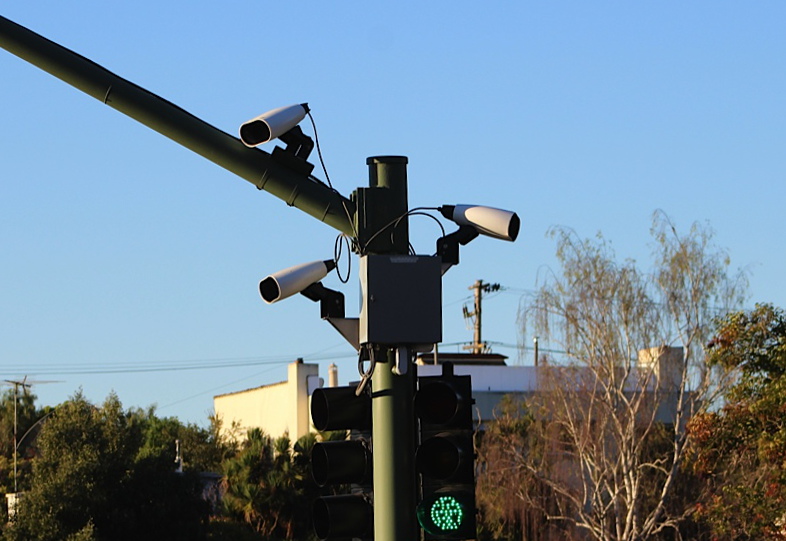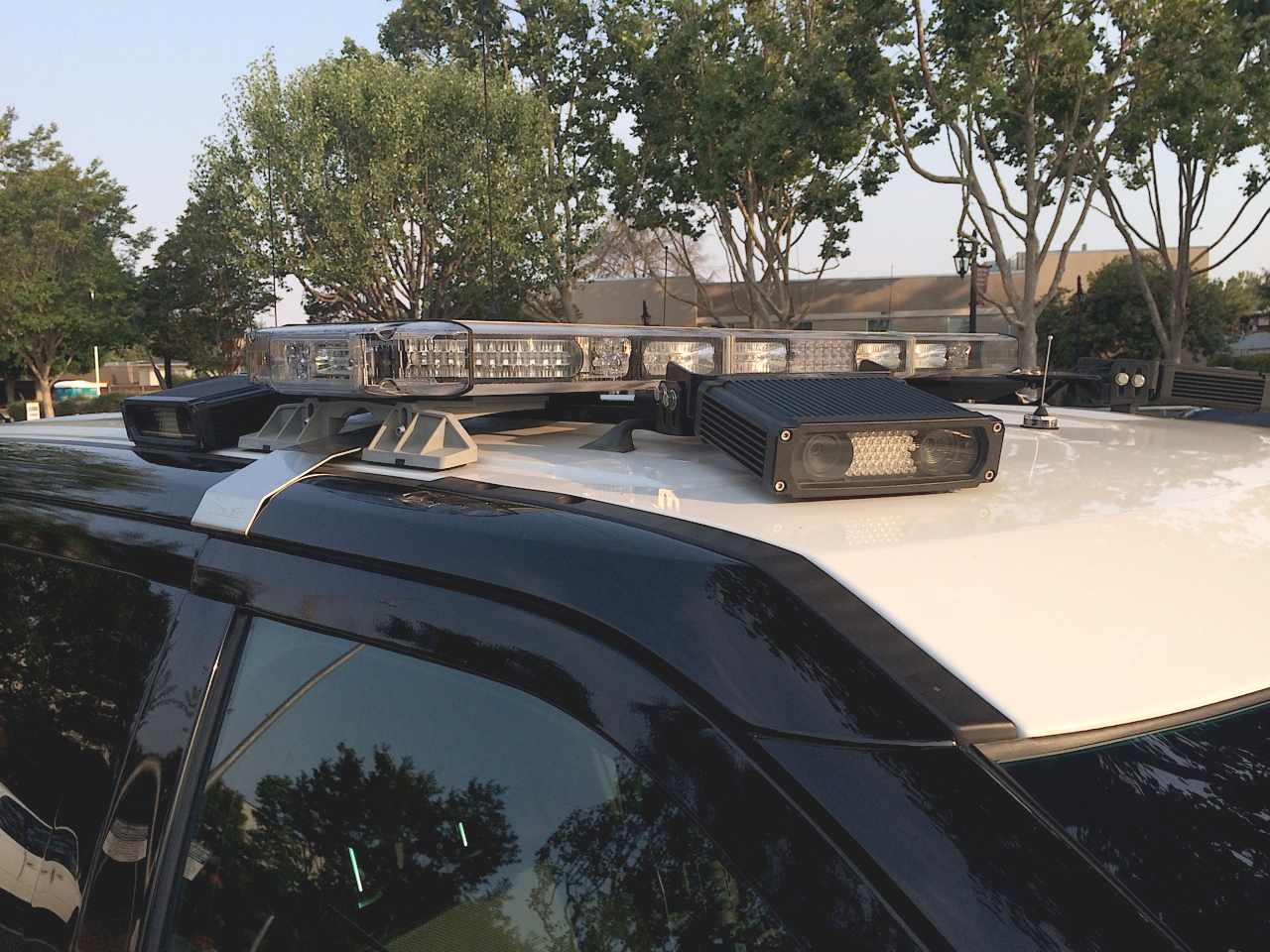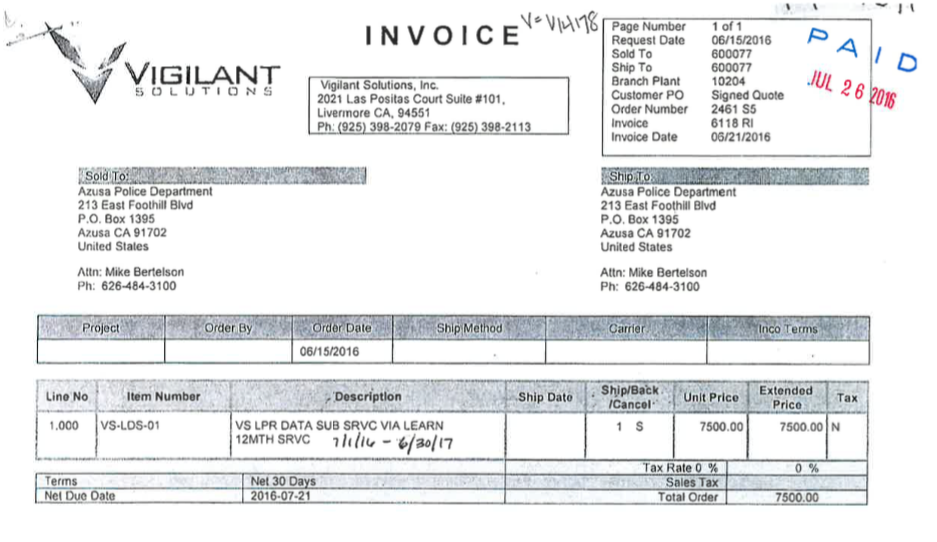What Is License Plate Camera
Automatic license plate readers (ALPRs) are high-speed, computer-controlled camera systems that are typically mounted on street poles, streetlights, highway overpasses, mobile trailers, or attached to law team cars. ALPRs automatically capture all license plate numbers that come into view, along with the location, appointment, and time. The data, which includes photographs of the vehicle and sometimes its driver and passengers, is then uploaded to a key server.
Vendors say that the information nerveless tin be used by police to discover out where a plate has been in the past, to make up one's mind whether a vehicle was at the scene of a law-breaking, to identify travel patterns, and even to detect vehicles that may be associated with each other. Police enforcement agencies can choose to share their data with thousands of other agencies.
Taken in the aggregate, ALPR data can paint an intimate portrait of a driver's life and fifty-fifty chill Commencement Amendment protected activity. ALPR technology can be used to target drivers who visit sensitive places such as wellness centers, immigration clinics, gun shops, union halls, protests, or centers of religious worship.
Drivers accept no control over whether their vehicle displays a license plate considering the government requires all car, truck, and motorcycle drivers to display license plates in public view. So it's especially disturbing that automatic license plate readers are used to rails and record the movements of millions of ordinary people, even though the overwhelming majority are non connected to a offense.
How ALPRs Work
Automated license plate readers can be broadly divided into two categories.
Stationary ALPR cameras

Photo by Mike Katz-Lacabe (CC BY)
These are installed in a stock-still location, such every bit a traffic calorie-free, a telephone pole, the entrance of a facility, or a thruway go out ramp. These cameras generally capture simply vehicles in motility that laissez passer within view.
If multiple stationary ALPR cameras are installed along a single thoroughfare, the data tin reveal what direction and what speed a machine is traveling. If the information are stored over time, they tin can reveal every time a particular plate has passed a given location, allowing the government to infer that the driver probable lives or works shut by.
Stationary cameras can sometimes be moved. For example, surveillance vans or truck trailers can be outfitted with ALPR systems and and then parked at strategic locations, such equally gun shows or political rallies.
ALPR cameras are often used in conjunction with automated red-calorie-free and speed enforcement systems, and also equally a means of assessing tolls on roads and bridges.
Mobile ALPR cameras

Photo past Mike Katz-Lacabe (CC By)
These are often attached to police force patrol cars, allowing law enforcement officers to capture data from license plates as they drive around the city throughout their shifts. In nigh cases, these cameras are turned on at the starting time of a shift and non turned off over again until the end of the shift. Also, individual vendors like Vigilant Solutions capture plate data with mobile ALPRs and so sell that data to police force agencies and others.
In addition to capturing images of passing vehicles, mobile ALPR cameras are constructive at capturing license plates of parked cars. For case, a patrol car may drive around a public parking lot capturing hundreds of vehicles' plates in minutes.
ALPR Databases
Most of this ALPR information is stored in databases for extended periods of time—often as much as v years. The databases may be maintained by the police departments, but often they are maintained past private companies such as Vigilant Technologies. Law enforcement agencies without their own ALPR systems tin can admission data collected by other law enforcement agencies through regional sharing systems and networks operated by these private companies. Several companies operate contained, non-law enforcement ALPR databases, contracting with drivers to put cameras on private vehicles to collect the information. These data are then sold to companies like insurers, but police enforcement can also purchase access to this commercial data on a subscription basis.
Hotlists
Law enforcement agencies volition often pre-load a listing of license plates that the ALPR organisation is actively looking for—such every bit stolen vehicles and vehicles associated with outstanding warrants. Constabulary officers tin also create their own hotlists. If the ALPR camera scans a plate on the listing, the organisation sends an alert to the officer in the squad car (if information technology'due south a mobile reader) or the agency (if information technology'south a fixed reader). Some hotlists include depression-level misdemeanors and traffic offenses. Some agencies apply these hotlists to generate acquirement by stopping citation scofflaws.
What Kinds of Data ALPRs Collect
ALPRs collect license plate numbers and location information along with the exact date and fourth dimension the license plate was encountered. Some systems are able to capture make and model of the vehicle. They tin collect thousands of plates per minute. One vendor brags that its dataset includes more than 6.5 billion scans and grows at a rate of 120-meg data points each month.
When combined, ALPR information tin can reveal the direction and speed a person traveled through triangulation. In aggregate over fourth dimension, the data can reveal a vehicle's historical travel. With algorithms applied to the information, the systems can reveal regular travel patterns and predict where a driver may be in the futurity. The information as well reveal all visitors to a particular location.
The data generally does non include the driver'due south proper noun. However, law enforcement officers can use other databases to connect individual names with their license plate numbers.
In addition to capturing license plate data, the photographs can reveal images of the vehicle, the vehicle's drivers and passengers, also as its firsthand surroundings—and even people getting in and out of a vehicle. A 2009 privacy impact assessment report indicates that the photographs may fifty-fifty include bumper stickers, which could reveal data on the political or social views of the driver.
How Law Enforcement Uses ALPRs
ALPR data is gathered indiscriminately, collecting information on millions of ordinary people. By plotting vehicle times and locations and tracing past movements, police force can use stored data to paint a very specific portrait of drivers' lives, determining past patterns of beliefs and possibly fifty-fifty predicting future ones—in spite of the fact that the vast bulk of people whose license plate data is collected and stored accept non even been accused of a crime. Without ALPR technology, police force enforcement officers must collect license plates by hand. This creates applied limitations on the amount of data that can be collected and means officers must brand choices about which vehicles they are going to rails. ALPR applied science removes those limitations and allows officers to track everyone, allowing for faster and broader collection of license plates with far reduced staffing requirements.
Law enforcement has ii general purposes for using license plate readers.
Real-time investigations
By calculation a license plate to a "hot listing," officers tin can utilize ALPR to automatically identify or rail detail vehicles in existent time. Licenses plates are often added to hot lists because the vehicle is stolen or associated with an outstanding warrant. Officers may also add together a plate number to the listing if the vehicle has been seen at the scene of a offense, the owner is a doubtable in a crime, or the vehicle is believed to be associated with a gang. Hot lists often include low-level offenses, too.
Historical investigations
Since ALPRs typically collect information on everyone—not just hot-listed vehicles—officers can utilise a plate, a partial plate, or a concrete accost to search and clarify historical data. For example, an officer may enter the location of a convenience store to identify vehicles seen nearby at the fourth dimension of a robbery. The officeholder can and then expect up those plate numbers to notice other locations that plate has been captured.
Training materials, policies and laws in some jurisdictions instruct officers that a hot-list alert on its own may not exist enough to warrant a stop. Officers are instructed to visually confirm that a plate number is a match. Failure to manually confirm, combined with machine fault, has caused wrongful stops.
Police force enforcement claims that ALPR data has been used to, for example, recover stolen cars or observe abducted children. Even so, law have likewise used ALPR data for mass enforcement of less serious offenses, such as searching for uninsured drivers or tracking downwardly individuals with overdue court fees.
The ACLU estimates that less than 0.two percent of plate scans are linked to criminal activity or vehicle registration problems. Many police enforcement agencies store ALPR data for years, and share it with other police force enforcement agencies and federal agencies.
The length of time that ALPR data is retained varies from bureau to agency, from as brusk every bit mere days to as long as several years, although some entities—including individual companies—may retain the data indefinitely.
Who Sells ALPR Technology

Vigilant Solutions and ELSAG are the largest ALPR vendors.
Vigilant Solutions' subsidiary Digital Recognition Network, forth with MVTrac, are the two main companies hiring contractors to collect ALPR data beyond the country. The companies and then share the commercially-collected information non only with law enforcement simply also with auto recovery (aka "repo") companies, banks, credit reporting agencies, and insurance companies.Data collected past individual entities does not accept memory limits and is non subject to sunshine laws, or any of the other safeguards that are sometimes establish in the regime sector.
Some jurisdictions use ALPR technology originally developed by PIPS, which was subsequently sold to 3M. The ALPR division was more recently caused by Neology, Inc.
Threats Posed by ALPR
ALPR is a powerful surveillance technology that can be used to invade the privacy of individuals also every bit to violate the rights of unabridged communities.
Police force enforcement agencies have abused this technology. Constabulary officers in New York drove downward a street and electronically recorded the license plate numbers of everyone parked near a mosque. Police in Birmingham targeted a Muslim community while misleading the public most the project. ALPR data EFF obtained from the Oakland Police Department showed that police force disproportionately deploy ALPR-mounted vehicles in low-income communities and communities of colour.
Moreover, many private officers accept abused law enforcement databases, including license plate information and records held by motor vehicle departments. In 1998, a Washington, D.C. police officer "pleaded guilty to extortion after looking upward the plates of vehicles near a gay bar and blackmailing the vehicle owners." Constabulary officers have also used databases to search romantic interests in Florida. A former female police officeholder in Minnesota discovered that her driver'south license tape was accessed 425 times by eighteen different agencies beyond the country.
In addition to deliberate misuse, ALPRs sometimes misread plates, leading to dire consequences. In 2009, San Francisco constabulary pulled over Denise Greenish, an African-American metropolis worker, handcuffed her at gunpoint, forced her to her knees, and searched both her and her vehicle—all because her automobile was misidentified as stolen due to a license plate reader error. Her experience led the U.S. Ninth Circuit Court of Appeals to dominion that applied science lone tin can't be the basis of such a stop, but that judgment does not apply everywhere, leaving people vulnerable to similar police force enforcement errors.
Aggregate data stored for lengthy periods of time (or indefinitely) becomes more invasive and revealing, and information technology is susceptible to both misuse and data breach. Sensible retention limits, specific policies about who within an agency is allowed to access data, and audit and command processes could assistance minimize these issues. One of the better privacy protections would be for police to retain no information at all when a passing vehicle does not match a hot list.
EFF's Piece of work on ALPR
EFF has been investigating and combating the privacy threats of ALPR engineering through public records requests, litigation, and legislative advocacy since 2012.
ALPR Litigation
EFF and the ACLU of Southern California sued the Los Angeles County Sheriff'south Department and the Los Angeles Police force Department afterwards the agencies refused to hand over ALPR data. The agencies claimed the records were exempt from the California Public Records Act because they were investigative records. This statement amounts to challenge that all Los Angelenos are nether investigation, a point that both a lawyer for the LAPD and a California Supreme Court Justice agreed sounded "Orwellian" during oral arguments. In 2017, the California Supreme Court ruled in EFF and ACLU's favor and ordered the case back to the Superior court.
Outside of California, EFF has filed briefs in a lawsuit over the excessive storage drove of ALPR data in the land of Virginia.
ALPR Accountability and Transparency
In 2015, the California legislature passed Southward.B. 34, a bill that requires ALPR users to protect information, maintain admission logs, agree public meetings before starting an ALPR programme, implement a usage and privacy policy, and maintain access logs. The law likewise prohibits public agencies from selling, sharing, or transferring ALPR information except to other public agencies.
EFF has coordinated volunteers to collect ALPR policies across the state of California and to betrayal agencies failing to comply with the constabulary. EFF has also independently filed public records requests with dozens of agencies to shine light on their utilise of ALPR data.
ALPR Security
EFF investigated more than 100 ALPR cameras operated past constabulary enforcement that were leaking data because of misconfiguration. These cameras were inadvertently publicly accessible through web browsers and Telnet interfaces. After EFF disclosed these vulnerabilities, several agencies in Louisiana and California overhauled their ALPR networks.
We have also contacted public safety agencies whose ALPR data was exposed online, often on websites accessible to anyone with a spider web browser, to responsibly disembalm the security vulnerabilities we constitute.
EFF Legal Cases
ACLU of Southern California and EFF v. LAPD and LASD
Neal v. Fairfax Canton Police Department
For More than Data
You Are Being Tracked (ACLU)
License Plate Readers for Police force Enforcement Opportunities and Obstacles (RAND Corporation)
Automated License Plate Readers Threaten Our Privacy (EFF/ACLU)
The Iv Flavors of Automated License Plate Reader Technology (EFF)
Most recently updated August 28, 2017
Source: https://www.eff.org/id/pages/automated-license-plate-readers-alpr
Posted by: hayescamagirse.blogspot.com


0 Response to "What Is License Plate Camera"
Post a Comment